-
United States -
United Kingdom -
India -
France -
Deutschland -
Italia -
日本 -
대한민국 -
中国 -
台灣
-
Ansys는 학생들에게 시뮬레이션 엔지니어링 소프트웨어를 무료로 제공함으로써 오늘날의 학생들의 성장을 지속적으로 지원하고 있습니다.
-
Ansys는 학생들에게 시뮬레이션 엔지니어링 소프트웨어를 무료로 제공함으로써 오늘날의 학생들의 성장을 지속적으로 지원하고 있습니다.
-
Ansys는 학생들에게 시뮬레이션 엔지니어링 소프트웨어를 무료로 제공함으로써 오늘날의 학생들의 성장을 지속적으로 지원하고 있습니다.
ANSYS BLOG
April 29, 2020
How to Encourage Multidisciplinary Design with Examples in the Classroom
Modern engineering solutions require multidisciplinary design.
For instance, consider the automotive industry. They started with a design cycle focused on mechanical engineering. Now, the industry has evolved to champion multidisciplinary design optimization cycles that include:
- Materials science
- Electrical engineering
- Fluid dynamics
- Artificial intelligence
- Electronic design
So, how does one prepare future engineers to embrace this new design approach when their bachelor’s degree focuses on a specific discipline?
The automotive industry went from focusing on mechanical engineering to multidisciplinary design optimization.
Capstone projects could serve as an opportunity for students to explore this bird’s eye view approach. However, these projects tend to occur too late in the curriculum to give the topic justice.
In response, many engineering programs are starting to teach multidisciplinary design at an introductory level through the use of product design examples.
Product examples can range in complexity from a teacup to a hip replacement. But regardless of how complex they are, they can be used to show the interactions between different engineering disciplines. By connecting these engineering design fundamentals with familiar products, professors can build stronger links and a better understanding for their students.
The challenge is that sourcing product examples can be difficult. Professors will need access to various details that are not common knowledge, such as:
- Production scale
- Materials properties
- Manufacturing processes
With Ansys GRANTA EduPack 2020, professors will be able to gather this data so they can include multidisciplinary design optimization examples in their curricula. This tool is currently available, so listen to the Materials Education using Ansys GRANTA EduPack 2020 webinar to find out more.
Teach Multidisciplinary Design Optimization Using Product Examples
GRANTA EduPack provides an engaging, visual and interactive user interface that enables professors and students to progress through large databases of material and process attributes by exploration, search and selection.
In particular, the new release has introduced two databases that focus on product design and medical devices.
A list of the different GRANTA EduPack Databases. The two new databases focus on design and medical devices. The current database choices enable a wide range of engineering and design disciplines to interact with materials data in a visual way.
The design database highlights a wide variety of products — from interior furniture to sporting goods and leisure devices. Each datasheet includes information on the product’s:
- Manufacturer
- Style
- Materials
- Production
The addition of design attributes enables students to explore the human aspect of multidisciplinary design optimization. As a result, this teaches them to develop better products by embracing communication between others in the development process — like designers and artists.
The homepage of the Design database is visual in nature. This encourages students to explore products based on their personal interests.
As for the medical device database, its healthcare focus offers professors a collection of 50 medical devices from the cardiovascular, orthopedic and dental systems that students will be familiar with. Each record is linked to real-life FDA approved examples, which can act as excellent discussion starting points for both biomedical and other engineering courses.
Like other GRANTA EduPack databases, the design and medical device databases include Materials and Process Universe data. So, users can expect the same level of detail and quality.
GRANTA EduPack 2020 is now available. Listen to the Materials Education using Ansys GRANTA EduPack 2020 webinar to learn about all it has to offer for introductory and advanced courses.
Any and all ANSYS, Inc. brand, product, service and feature names, logos and slogans such as Ansys and Ansys GRANTA are registered trademarks or trademarks of ANSYS, Inc. or its subsidiaries in the United States or other countries.













